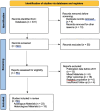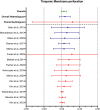Heterologous Materials Are Really Better than Autologous in Tympanoplasty Mastoid Obliteration? A Systematic Review with Meta-Analysis
- PMID: 39390967
- PMCID: PMC11562477
- DOI: 10.5152/iao.2024.241262
Heterologous Materials Are Really Better than Autologous in Tympanoplasty Mastoid Obliteration? A Systematic Review with Meta-Analysis
Abstract
The aim is to analyze Literature concerning mastoid obliteration in adults with either autologous or heterologous grafts in the last 10 years. Data Source: Databases such as NIH PubMed, Bookshelf, NLM Catalog, Cochrane Library, and Embase were consulted. Thirty-seven studies were selected (22 concerning autologous materials, 15 about heterologous ones). Only studies with more than 12 months of follow-up were considered. A statistical analysis with random-effects models was performed to allow the true effect sizes to differ from study to study. The present literature review and meta-analysis does not allow to establish the supremacy of one technique over the other, but underlines the advantages of each reconstructive choice and the importance of mastoid obliteration in cholesteatoma surgery. The total number of obliterated ears was 2882. Overall otorrhea rate was 5% (5.2% for heterologous grafts; 4.9% for autologous materials; P < .05). Recurrent and residual cholesteatoma rate was 4.5% (3.4% in heterologous materials; 5.2% in autologous grafts; P < .05). Recurrent cholesteatoma rate was 1.8% (1.6% when using heterologous grafts, 1.9% with autologous; P < .05). Residual cholesteatoma rate was 1.5% (1.6% with heterologous materials, 1.5% with autologous; P < .05). TM (tympanic membrane) retraction pockets rate was 5.3% (3.6% with heterologous materials; P >.05; 7% with autologous materials; P < .05). TM perforations rate was 2.9% (4.3% with heterologous materials, 2.5% with autologous; P < .05). Infection rate was 2.3% (2.3% with heterologous materials, 2.2% with autologous; P < .05). Heterologous materials are associated with significantly lower rates of recurrent and residual cholesteatoma and retraction pockets development, although they are associated with higher rates of otorrhea and TM perforation.
Conflict of interest statement
Figures





Similar articles
-
Long-term follow-up results of canal wall down tympanoplasty with mastoid obliteration using the bone pate plate for canal wall reconstruction in cholesteatoma surgery.Otol Neurotol. 2014 Jul;35(6):961-5. doi: 10.1097/MAO.0000000000000414. Otol Neurotol. 2014. PMID: 24853244
-
Total mastoid obliteration in staged canal-up tympanoplasty for cholesteatoma facilitates tympanic aeration.Otol Neurotol. 2009 Sep;30(6):766-70. doi: 10.1097/MAO.0b013e3181b23698. Otol Neurotol. 2009. PMID: 19704361
-
Single-Stage Mastoid Obliteration in Cholesteatoma Surgery and Recurrent and Residual Disease Rates: A Systematic Review.JAMA Otolaryngol Head Neck Surg. 2018 May 1;144(5):440-446. doi: 10.1001/jamaoto.2017.3401. JAMA Otolaryngol Head Neck Surg. 2018. PMID: 29543959
-
[Application of autogenous bone pate for atticus reconstruction and mastoid cavity obliteration in tympanoplasty with mastoidectomy].Lin Chuang Er Bi Yan Hou Tou Jing Wai Ke Za Zhi. 2013 Jun;27(11):604-6. Lin Chuang Er Bi Yan Hou Tou Jing Wai Ke Za Zhi. 2013. PMID: 23987013 Clinical Trial. Chinese.
-
Mastoid obliteration versus canal wall down or canal wall up mastoidectomy for cholesteatoma: Systematic review and meta-analysis.Am J Otolaryngol. 2023 Mar-Apr;44(2):103751. doi: 10.1016/j.amjoto.2022.103751. Epub 2022 Dec 27. Am J Otolaryngol. 2023. PMID: 36586321
References
Publication types
MeSH terms
LinkOut - more resources
Full Text Sources
